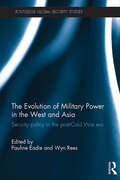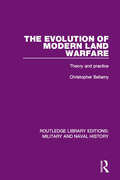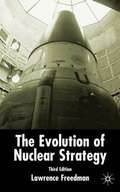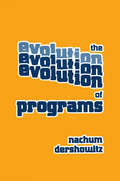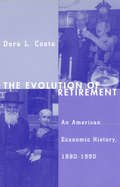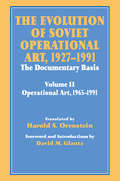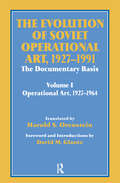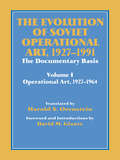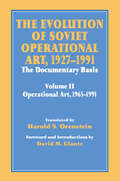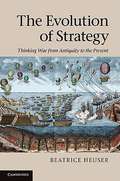- Table View
- List View
Evolution of Italian Enterprises in the 20th Century (Contributions to Economics)
by Renato Giannetti Michelangelo VastaDuring the first two-thirds of the 20th century the themes of sectorial structure and compared performance prevail in Italian economic historiography. In contrast, in the last part of the century attention is focused on the behavior of single economic actors and their micro-economic strategies. This book intends to act as a bridge between the two approaches, and reconstructs the secular journey of Italian industrial enterprise through an original study.
The Evolution of Knowledge: Rethinking Science for the Anthropocene
by Jürgen RennA fundamentally new approach to the history of science and technologyThis book presents a new way of thinking about the history of science and technology, one that offers a grand narrative of human history in which knowledge serves as a critical factor of cultural evolution. Jürgen Renn examines the role of knowledge in global transformations going back to the dawn of civilization while providing vital perspectives on the complex challenges confronting us today in the Anthropocene—this new geological epoch shaped by humankind.Renn reframes the history of science and technology within a much broader history of knowledge, analyzing key episodes such as the evolution of writing, the emergence of science in the ancient world, the Scientific Revolution of early modernity, the globalization of knowledge, industrialization, and the profound transformations wrought by modern science. He investigates the evolution of knowledge using an array of disciplines and methods, from cognitive science and experimental psychology to earth science and evolutionary biology. The result is an entirely new framework for understanding structural changes in systems of knowledge—and a bold new approach to the history and philosophy of science.Written by one of today's preeminent historians of science, The Evolution of Knowledge features discussions of historiographical themes, a glossary of key terms, and practical insights on global issues ranging from climate change to digital capitalism. This incisive book also serves as an invaluable introduction to the history of knowledge.
The Evolution of Medical Genetics: A British Perspective
by Peter S. HarperThis informative new book presents an accessible account of the development of medical genetics over the past 70 years, one of the most important areas of 20th, and now 21st, century science and medicine. Based largely on the author’s personal involvement and career as a leader in the field over the last half century, both in the UK and internationally, it draws on his interest and involvement in documenting the history of medical genetics. Underpinning the content is a unique series of 100 recorded interviews undertaken by the author with key older workers in the field, the majority British, providing invaluable information going back to the very beginnings of human and medical genetics. Focusing principally on medically relevant areas of genetics rather than the underlying basic science and technological aspects, the book offers a fascinating insight for those working and training in the field of clinical or laboratory aspects of medical genetics, genomics and allied areas; it will also be of interest to historians of science and medicine and to workers in the social sciences who are increasingly attracted by the social and ethical challenges posed by modern medical genetics and genomics.
The Evolution of Medical Genetics: A British Perspective
by Peter S. HarperThis informative new book presents an accessible account of the development of medical genetics over the past 70 years, one of the most important areas of 20th, and now 21st, century science and medicine. Based largely on the author’s personal involvement and career as a leader in the field over the last half century, both in the UK and internationally, it draws on his interest and involvement in documenting the history of medical genetics. Underpinning the content is a unique series of 100 recorded interviews undertaken by the author with key older workers in the field, the majority British, providing invaluable information going back to the very beginnings of human and medical genetics. Focusing principally on medically relevant areas of genetics rather than the underlying basic science and technological aspects, the book offers a fascinating insight for those working and training in the field of clinical or laboratory aspects of medical genetics, genomics and allied areas; it will also be of interest to historians of science and medicine and to workers in the social sciences who are increasingly attracted by the social and ethical challenges posed by modern medical genetics and genomics.
Evolution of Metal Casting Technologies: A Historical Perspective (SpringerBriefs in Applied Sciences and Technology)
by Muhammad Azhar Khan Anwar Khalil Sheikh Bilal Suleiman Al-ShaerThis book provides an overview of metal casting technologies starting from its historical evolution to casting design strategies that are being followed today in foundries and other metal casting industries. The details of most of the casting processes and their applications are also included for completeness. Foundry practices such as mold materials and molding techniques, pattern making and cores, furnaces, pouring, cleaning and heat treatment etc. are discussed in detail. Finally, current practices in casting design are demonstrated. Further developments in the field through computational methods and virtual reality are also described.
The Evolution of Military Power in the West and Asia: Security Policy in the Post-Cold War Era (Routledge Global Security Studies)
by Pauline Eadie Wyn ReesThis book investigates how states in both the West and Asia have responded to multi-dimensional security challenges since the end of the Cold War, focusing on military transformation. Looking at a cross-section of different countries, this volume assesses how their armed forces have responded to a changing international security context. The book investigates two main themes. First, how the process of military ‘transformation’- in terms of technological advances and new ways of conducting warfare - has impacted on the militaries of various countries. These technologies are hugely expensive and the extent to which different states can afford them, and the ability of these states to utilise these technologies, differs greatly. Second, the volume investigates the social dimensions of military transformation. It reveals the expanding breadth of tasks that contemporary armed forces have been required to address. This includes the need for military forces to work with other actors, such as non-governmental agencies and humanitarian organisations, and the ability of armed forces to fight asymmetric opponents and conduct post-conflict reconstruction tasks. The conflicts in Iraq and Afghanistan exemplified how important the relationship between technological and social transformation has become. This book will be of much interest to students of strategic studies, military innovation, Asian politics, security studies and International Relations.
The Evolution of Military Power in the West and Asia: Security Policy in the Post-Cold War Era (Routledge Global Security Studies)
by Pauline Eadie and Wyn ReesThis book investigates how states in both the West and Asia have responded to multi-dimensional security challenges since the end of the Cold War, focusing on military transformation. Looking at a cross-section of different countries, this volume assesses how their armed forces have responded to a changing international security context. The book investigates two main themes. First, how the process of military ‘transformation’- in terms of technological advances and new ways of conducting warfare - has impacted on the militaries of various countries. These technologies are hugely expensive and the extent to which different states can afford them, and the ability of these states to utilise these technologies, differs greatly. Second, the volume investigates the social dimensions of military transformation. It reveals the expanding breadth of tasks that contemporary armed forces have been required to address. This includes the need for military forces to work with other actors, such as non-governmental agencies and humanitarian organisations, and the ability of armed forces to fight asymmetric opponents and conduct post-conflict reconstruction tasks. The conflicts in Iraq and Afghanistan exemplified how important the relationship between technological and social transformation has become. This book will be of much interest to students of strategic studies, military innovation, Asian politics, security studies and International Relations.
The Evolution of Modern Land Warfare: Theory and Practice (Routledge Library Editions: Military and Naval History)
by Christopher BellamyExtensively illustrated with 52 detailed campaign and battle maps and diagrams, this book, originally published in 1990, surveys the evolution of warfare in Europe from Napoleon to the end of the twentieth century and in Asia from the Middle Ages. It considers the interaction of technology and warfare. With wide-ranging examples, the book includes two in depth case studies, one on the Soviet Operational Manoeuvre Group and its predecessors in the Russian Imperial Army, the other on the history of land warfare, including guerilla warfare, in Asia. In this book the author demonstrates that military history can be of immense practical help to the modern military analyst and professional. Now updated with a new introduction to take into account changes since 1990, this book remains of essential value to students, teachers & professionals in political & social history, international relations, defence, war & peace studies.
The Evolution of Modern Land Warfare: Theory and Practice (Routledge Library Editions: Military and Naval History)
by Christopher BellamyExtensively illustrated with 52 detailed campaign and battle maps and diagrams, this book, originally published in 1990, surveys the evolution of warfare in Europe from Napoleon to the end of the twentieth century and in Asia from the Middle Ages. It considers the interaction of technology and warfare. With wide-ranging examples, the book includes two in depth case studies, one on the Soviet Operational Manoeuvre Group and its predecessors in the Russian Imperial Army, the other on the history of land warfare, including guerilla warfare, in Asia. In this book the author demonstrates that military history can be of immense practical help to the modern military analyst and professional. Now updated with a new introduction to take into account changes since 1990, this book remains of essential value to students, teachers & professionals in political & social history, international relations, defence, war & peace studies.
The Evolution of Music through Culture and Science
by Peter TownsendThe Evolution of Music by Culture and Science aims to recognise the impact of science on music, why it occurs, how we respond, and even to tentatively see if we can predict future developments. Technology has played an immense role in the development of music as it has enabled the production of new sounds, introduced new instruments and continuously improved and modified existing ones. Printing, musical notation, and modern computer aids to composition, plus recordings and electronic transmission have equally enabled us to have access to music from across the world. Such changes, whether just more powerful pianos, or new sounds as from the saxophone, have inspired composers and audiences alike. Acoustics and architecture play similar roles as they changed the scale and performance of concert halls, and with the advent of electronics, they enabled vast pop music festivals. No aspect of modern music making has been untouched by the synergy with scientific innovation. This is not a one-way interaction as the early attempts to make recordings were a major motivating force to design the electronics for amplifiers and these in turn inspired and enabled the designs of semiconductor electronics and modern computer technology. To appreciate the impact of technology on music does not require any prior scientific background as the concepts are invariably extremely simple and are presented here without technical detail. Understanding music and why we like different genres is far more complex, as this involves our personal background and taste. Both aspects change with time, and there is no contradiction in enjoying items as diverse as baroque madrigals, symphonies, jazz or pop music, or music from totally different cultures.
The Evolution of Nordic Finance (Palgrave Macmillan Studies in Banking and Financial Institutions)
by Steffen Elkiær AndersenThe book describes the birth and growth of financial institutions and stock exchanges in Scandinavia and Finland from 1656 to 2010, including their banking crises and the history of banking regulation. It argues that quantitative regulations cannot, in the long run, produce the desired results and bear the seeds of future financial crises.
Evolution of Nuclear Strategy (PDF)
by Lawrence FreedmanFirst published twenty years ago, Lawrence Freedman's Evolution of Nuclear Strategy was immediately acclaimed as a seminal work on the history of attempts to cope militarily and politically with the terrible destructive power of nuclear weapons. This new edition takes the story beyond the end of the cold war, through the Gulf War and new arguments about missile defence and 'rogue states', up to the impact of the events of 11 September 2001. While the removal of the Warsaw Pact from the scene brought to an abrupt end many of the debates that had dominated strategic discourse for the previous four decades, the basic question of whether or not this destructive power could be used for political ends, and how best to stop others trying to do so, remained. In one volume the reader can trace the story of nuclear strategy from its roots in thinking about airpower in the first decades of the Twentieth Century to arguments about how to deal with the possibility of nuclear terrorism in the Twenty-First. There is full coverage of how the west came to rely on nuclear weapons to deter Soviet aggression and the major problems of credibility that soon opened up as the Soviet Union developed its own nuclear capability. The highlights of the ensuing strategic debate are described, and the contributions of the leading figures in these debates are examined. The extent to which the theorising influenced the formation of policy in the major nuclear powers is explored. At all times the wider political context is kept in view, demonstrating the factors which shaped the nuclear legacy with which each new generation must cope.
The Evolution of Obesity
by Jay Schulkin Michael L. PowerIn this sweeping exploration of the relatively recent obesity epidemic, Michael L. Power and Jay Schulkin probe evolutionary biology, history, physiology, and medical science to uncover the causes of our growing girth. The unexpected answer? Our own evolutionary success.For most of the past few million years, our evolutionary ancestors' survival depended on being able to consume as much as possible when food was available and to store the excess energy for periods when it was scarce. In the developed world today, high-calorie foods are readily obtainable, yet the propensity to store fat is part of our species' heritage, leaving an increasing number of the world's people vulnerable to obesity. In an environment of abundant food, we are anatomically, physiologically, metabolically, and behaviorally programmed in a way that makes it difficult for us to avoid gaining weight.Power and Schulkin’s engagingly argued book draws on popular examples and sound science to explain our expanding waistlines and to discuss the consequences of being overweight for different demographic groups. They review the various studies of human and animal fat use and storage, including those that examine fat deposition and metabolism in men and women; chronicle cultural differences in food procurement, preparation, and consumption; and consider the influence of sedentary occupations and lifestyles.A compelling and comprehensive examination of the causes and consequences of the obesity epidemic, The Evolution of Obesity offers fascinating insights into the question, Why are we getting fatter?
The Evolution of Pragmatism in India: Ambedkar, Dewey, and the Rhetoric of Reconstruction
by Scott R. StroudThe story of how the Indian reformer Bhimrao Ambedkar reimagined John Dewey’s pragmatism. In The Evolution of Pragmatism in India, Scott R. Stroud delivers a comprehensive exploration of the influence of John Dewey’s pragmatism on Bhimrao Ambedkar, architect of the Republic of India’s constitution. Stroud traces Ambedkar’s development in Dewey’s Columbia University classes in 1913–1916 through his final years in 1950s India when he rewrote the story of Buddhism. Stroud examines pragmatism’s influence not only on the philosophical ideas underpinning Ambedkar’s fight against caste oppression but also how his persuasive techniques drew on pragmatism’s commitment to reconstruction and meliorism. At the same time, Stroud is careful to point out the ways that Ambedkar pushed back against Dewey’s paradigm and developed his own approach to challenges in India. The result is a nuanced study of one of the most important figures in Indian history.
The Evolution of Pragmatism in India: Ambedkar, Dewey, and the Rhetoric of Reconstruction
by Scott R. StroudThe story of how the Indian reformer Bhimrao Ambedkar reimagined John Dewey’s pragmatism. In The Evolution of Pragmatism in India, Scott R. Stroud delivers a comprehensive exploration of the influence of John Dewey’s pragmatism on Bhimrao Ambedkar, architect of the Republic of India’s constitution. Stroud traces Ambedkar’s development in Dewey’s Columbia University classes in 1913–1916 through his final years in 1950s India when he rewrote the story of Buddhism. Stroud examines pragmatism’s influence not only on the philosophical ideas underpinning Ambedkar’s fight against caste oppression but also how his persuasive techniques drew on pragmatism’s commitment to reconstruction and meliorism. At the same time, Stroud is careful to point out the ways that Ambedkar pushed back against Dewey’s paradigm and developed his own approach to challenges in India. The result is a nuanced study of one of the most important figures in Indian history.
The Evolution of Programs (Progress in Computer Science and Applied Logic #5)
by DERSHOWITZ-Ecclesiastes 12:12 Programs are invariably subjected to many rorms or transrormation. After an initial version of a program has been designed and developed, it undergoes debugging and certification. In addition, most long-lived pro grams have a liCe-cycle that includes modifications to meet amended specifications and extensions for expanded capabilities. Such evolution ary aspects of programming are the topic of this monograph. We present rormal methods for manipulating programs and illustrate their applica tion with numerous examples. Such methods could be incorporated in semi-automated programming environments, where they would serve to ease the burden on the programmer. We begin by describing a method whereby a given program that achieves one goal can be modified to achieve a different goal or a pro gram that computes wrong results can be debugged to achieve the 2 Preface intended results. The abstraction of a set of cognate programs to obtain a program schema, and the instantiation of abstract schemata to solve concrete problems, are approached from the same perspective. In addition, we describe synthesis rules for generating code from specifications and annotation rules for making assertions about code. The synthesis rules may be used when a program is first being developed, or when, in the course of modifying a program, the need arises to rewrite a program segment. Annotation rules may be used for the purpose of determining what an incorrect program really does before attempting to debug it or how a correct program works before attempting to modify it.
The Evolution of Retirement: An American Economic History, 1880-1990 (National Bureau of Economic Research Series on Long-Term Factors in Economic Development)
by Dora L. CostaWinner of the 1998 Paul A. Samuelson Award given by TIAA-CREF, The Evolution of Retirement is the first comprehensive economic history of retirement in America. With life expectancies steadily increasing, the retirement rate of men over age 64 has risen drastically. Dora L. Costa looks at factors underlying this increase and shows the dramatic implications of her findings for both the general public and the U.S. government. Using statistical, and demographic concepts, Costa sheds light on such important topics as rising incomes and retirement, work and disease, the job prospects of older workers, living arrangements of the elderly, the development of a retirement lifestyle, and pensions and politics. "[Costa's] major contribution is to show that, even without Social Security and Medicare, retirement would have expanded dramatically."—Robert J. Samuelson, New Republic "An important book on a topic which has become popular with historians and is of major significance to politicians and economists."—Margaret Walsh, Business History
The Evolution of Retirement: An American Economic History, 1880-1990 (National Bureau of Economic Research Series on Long-Term Factors in Economic Development)
by Dora L. CostaWinner of the 1998 Paul A. Samuelson Award given by TIAA-CREF, The Evolution of Retirement is the first comprehensive economic history of retirement in America. With life expectancies steadily increasing, the retirement rate of men over age 64 has risen drastically. Dora L. Costa looks at factors underlying this increase and shows the dramatic implications of her findings for both the general public and the U.S. government. Using statistical, and demographic concepts, Costa sheds light on such important topics as rising incomes and retirement, work and disease, the job prospects of older workers, living arrangements of the elderly, the development of a retirement lifestyle, and pensions and politics. "[Costa's] major contribution is to show that, even without Social Security and Medicare, retirement would have expanded dramatically."—Robert J. Samuelson, New Republic "An important book on a topic which has become popular with historians and is of major significance to politicians and economists."—Margaret Walsh, Business History
The Evolution of Retirement: An American Economic History, 1880-1990 (National Bureau of Economic Research Series on Long-Term Factors in Economic Development)
by Dora L. CostaWinner of the 1998 Paul A. Samuelson Award given by TIAA-CREF, The Evolution of Retirement is the first comprehensive economic history of retirement in America. With life expectancies steadily increasing, the retirement rate of men over age 64 has risen drastically. Dora L. Costa looks at factors underlying this increase and shows the dramatic implications of her findings for both the general public and the U.S. government. Using statistical, and demographic concepts, Costa sheds light on such important topics as rising incomes and retirement, work and disease, the job prospects of older workers, living arrangements of the elderly, the development of a retirement lifestyle, and pensions and politics. "[Costa's] major contribution is to show that, even without Social Security and Medicare, retirement would have expanded dramatically."—Robert J. Samuelson, New Republic "An important book on a topic which has become popular with historians and is of major significance to politicians and economists."—Margaret Walsh, Business History
The Evolution of Social Institutions: Interdisciplinary Perspectives (World-Systems Evolution and Global Futures)
by Dmitri M. Bondarenko Stephen A. Kowalewski David B. SmallThis book presents a novel and innovative approach to the study of social evolution using case studies from the Old and the New World, from prehistory to the present. This approach is based on examining social evolution through the evolution of social institutions. Evolution is defined as the process of structural change. Within this framework the society, or culture, is seen as a system composed of a vast number of social institutions that are constantly interacting and changing. As a result, the structure of society as a whole is also evolving and changing. The authors posit that the combination of evolving social institutions explains the non-linear character of social evolution and that every society develops along its own pathway and pace. Within this framework, society should be seen as the result of the compound effect of the interactions of social institutions specific to it. Further, the transformation of social institutions and relations between them is taking place not only within individual societies but also globally, as institutions may be trans-societal, and even institutions that operate in one society can arise as a reaction to trans-societal trends and demands. The book argues that it may be more productive to look at institutions even within a given society as being parts of trans-societal systems of institutions since, despite their interconnectedness, societies still have boundaries, which their members usually know and respect. Accordingly, the book is a must-read for researchers and scholars in various disciplines who are interested in a better understanding of the origins, history, successes and failures of social institutions.
The Evolution of Soviet Operational Art, 1927-1991: The Documentary Basis: Volume 2 (1965-1991) (Soviet (Russian) Study of War)
by David M. Glantz Harold S. OrensteinThe Soviet military concept of operational art and the associated theories such as "war of annihilations", "deep battle", and "deep operations" have been observed by the West since World War II. The Soviet government hid their military-theoretical work behind a veil of secrecy. Here, the Soviet theories are revealed in the words of those who created them in peacetime and applied them in war.
The Evolution of Soviet Operational Art, 1927-1991: The Documentary Basis: Volume 1 (Operational Art 1927-1964) (Soviet (Russian) Study of War #No. 6-7)
by David M. Glantz Harold S. OrensteinThis collection of texts has been taken from formerly classified material in the official Red Army General Staff journal 'Military Thought'. The results are two volumes of great scope based on archival evidence. They stand as a compulsory reference point for anyone with an interest in the operational endeavours of the Soviet Army from the 1920's onward.
The Evolution of Soviet Operational Art, 1927-1991: The Documentary Basis: Volume 1 (Operational Art 1927-1964) (Soviet (Russian) Study of War)
by David M. Glantz Harold S. OrensteinThis collection of texts has been taken from formerly classified material in the official Red Army General Staff journal 'Military Thought'. The results are two volumes of great scope based on archival evidence. They stand as a compulsory reference point for anyone with an interest in the operational endeavours of the Soviet Army from the 1920's onward.
The Evolution of Soviet Operational Art, 1927-1991: The Documentary Basis: Volume 2 (1965-1991) (Soviet (Russian) Study of War #No. 6-7)
by David M. Glantz Harold S. OrensteinThe Soviet military concept of operational art and the associated theories such as "war of annihilations", "deep battle", and "deep operations" have been observed by the West since World War II. The Soviet government hid their military-theoretical work behind a veil of secrecy. Here, the Soviet theories are revealed in the words of those who created them in peacetime and applied them in war.
The Evolution Of Strategy: Thinking War From Antiquity To The Present (PDF)
by Beatrice HeuserIs there a 'Western way of war' which pursues battles of annihilation and single-minded military victory? Is warfare on a path to ever greater destructive force? This magisterial account answers these questions by tracing the history of Western thinking about strategy - the employment of military force as a political instrument - from antiquity to the present day. Assessing sources from Vegetius to contemporary America, and with a particular focus on strategy since the Napoleonic Wars, Beatrice Heuser explores the evolution of strategic thought, the social institutions, norms and patterns of behaviour within which it operates, the policies that guide it and the cultures that influence it. Ranging across technology and warfare, total warfare and small wars as well as land, sea, air and nuclear warfare, she demonstrates that warfare and strategic thinking have fluctuated wildly in their aims, intensity, limitations and excesses over the past two millennia. 9780521155243




